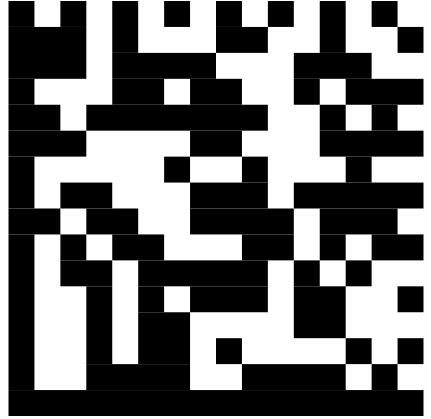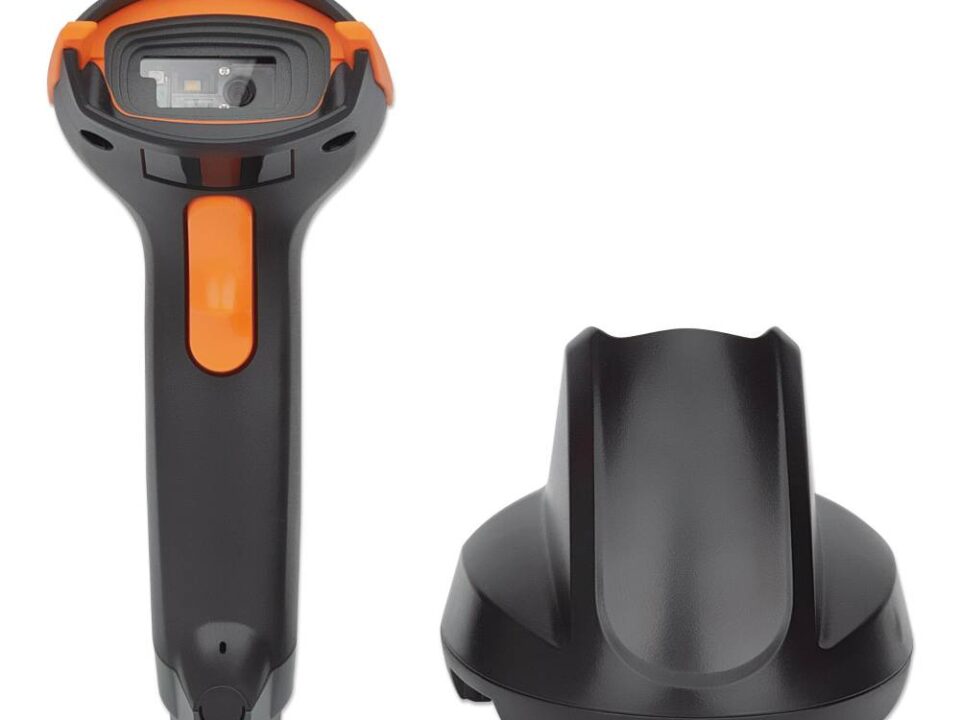What is a Data Matrix code?
Data Matrix (Data Matrix) is a two-dimensional code (also called a matrix) composed of black and white color blocks (cells) in squares or rectangles. It was developed by the American International Data Corporation in August 1994. The research and development is mainly used for parts, printed circuit boards, etc., and the American International Data Corporation was acquired by Microscan in 2008. [1][2][3] The encoded information may be text or digital data. The data size is usually a few to 1556 bytes. The length of the encoded data determines the number of color blocks in the matrix. Error correction codes are often used in encoding to increase reliability: even if one or more color blocks are damaged and unreadable, the information inside can still be read. A data matrix can store up to 2,335 numbers or letters.
Application of Data Matrix
The most popular application of Data Matrix is the label of small objects, because the code can encode 50 characters on an area of 2 or 3 square millimeters, and it is still readable at 20% contrast. [4] The size of the Data Matrix is not limited, and the images for commercial applications include planes as small as 300 microns (laser etched on a 600-micron silicon device) and as large as 1 meter (painted on the roof of a box car). The fidelity of the drawing and reading system is its only limitation.
Electronic Industries Alliance of America (EIA) recommends using Data Matrix to label small electronic components.
Printing Data Matrix codes on labels (English: Labels) or letters is becoming more and more common. Using a barcode reader (English: Barcode reader) can quickly read the code, so as to facilitate tracking of items, such as tracking the delivery of packages.
For industrial engineering, this barcode can also be directly marked on the component, so that the Data Matrix coded data can be used to identify the component. Manufacturers can use various methods to complete the components, but in the aerospace industry, barcodes are usually completed by industrial inkjet, dot matrix marking, laser marking, and electrochemical etching (ECE). These methods are used to obtain sustainable Permanent mark to the life of the component.
Data Matrix encoding is usually verified by professional camera equipment and software. This verification ensures that the coding complies with the relevant standards and ensures readability during the life of the component. After the component is put into use, the code can still be read and decoded by the reading lens, and the decoded information can be used for multiple purposes, such as movement tracking and inventory checking.
Data Matrix codes are the same as other open source codes (such as 1D Barcodes) and can also be read on mobile phones using specific mobile applications.
| Character Set | Length | Check Digit | Size, Module Width X, Print Ratio |
|---|---|---|---|
| ASCII | 1556 ASCII (8 Bit), 2335 alphanumerical or 3116 numeric characters | Error correction | Dynamically variable physical size from .001 inch square to 14.0 inches square; Please contact us for more details... |
| Applications | Used for encoding large amount of data characters; ideal for marking very small containers. Used by the pharmaceutical industry for unit dose and product marking. Originally developed for the Space Shuttle Program, where millions of parts must be tracked. | ||
| Notes | Two-dimensional matrix code that use a visual representation of binary code (0 or 1). | ||
Data Matrix code structure
Data Matrix code is a matrix two-dimensional code developed by ID Matrix in 1987, registered as AIMI’s ISS standard in 1996, and registered as an ISO/IEC standard in 2000.
| Specifications | ||
|---|---|---|
| Minimum size | 10 × 10 modules | |
| Maximum size | 144 × 144 modules | |
| Maximum data capacity | Value | 3116 characters |
| Alphanumeric | 2335 characters | |
Old versions of Data Matrix codes include ECC000, ECC050, ECC080, ECC100, and ECC140. ECC200 is the latest Data Matrix code version, which can be configured as a square or rectangle.
Specifications of Data Matrix code
Data Matrix code (ECC200) has two configurations: square and rectangular, and the number of cells is always even.
Square
| Square Data Matrix specifications (ECC200) | ||
|---|---|---|
| Minimum size | 10 × 10 modules | |
| Maximum size | 144 × 144 modules | |
| Maximum data capacity | Number | 3116 characters |
| Alphanumeric: | 2335 characters | |
| Binary: | 1556 characters | |
There are 24 character sizes in total, ranging from 10 × 10 modules to 144 × 144 modules. When the number of modules exceeds 24 × 24, the code will be divided into blocks, and each side will not exceed 24 modules. This structure prevents code distortion.
Rectangle
| Specifications of rectangular Data Matrix (ECC200) | ||
|---|---|---|
| Minimum size | 8 × 16 modules | |
| Maximum size | 16 × 48 modules | |
| Maximum data capacity | Number | 98 characters |
| Alphanumeric: | 72 characters | |
| Binary: | 47 characters | |
For rectangles, there are six sizes listed below.
•8 × 18 modules (1 block)
•12 × 26 modules (1 block)
•16 × 36 modules (1 block)
•8 × 32 modules (2 blocks)
•12 × 36 modules (2 blocks)
•16 × 48 modules (2 blocks)
How to determine the Data Matrix code size
The actual size of the Data Matrix code is calculated by multiplying the symbol size by the printable size of the module.
If the module size is 0.25 mm,
Symbol size: 10 × 10 modules = 2.5 × 2.5 mm
Symbol size: 32 × 32 modules = 8.0 × 8.0 mm
Symbol size: 8 × 18 modules = 2.0 × 4.5 mm
Data capacity of each symbol size
Square
| Number of modules | Data capacity | Error correction rate | ||
|---|---|---|---|---|
| Number | Alphanumeric | Binary | ||
| 10 x 10 | 6 | 3 | 1 | 25% |
| 12 x 12 | 10 | 6 | 3 | 25% |
| 14 x 14 | 16 | 10 | 6 | 28 to 39% |
| 16 x 16 | 24 | 16 | 10 | 25 to 38% |
| 18 x 18 | 36 | 25 | 16 | 22 to 34% |
| 20 x 20 | 44 | 31 | 20 | 23 to 38% |
| 22 x 22 | 60 | 43 | 28 | 20 to 34% |
| 24 x 24 | 72 | 52 | 34 | 20 to 35% |
| 26 x 26 | 88 | 64 | 42 | 19 to 35% |
| 32 x 32 | 124 | 91 | 60 | 18 to 34% |
| 36 x 36 | 172 | 127 | 84 | 16 to 30% |
| 40 x 40 | 228 | 169 | 112 | 15 to 28% |
| 44 x 44 | 288 | 214 | 142 | 14 to 27% |
| 48 x 48 | 348 | 259 | 172 | 14 to 27% |
| 52 x 52 | 408 | 304 | 202 | 15 to 27% |
| 64 x 64 | 560 | 418 | 278 | 14 to 27% |
| 72 x 72 | 736 | 550 | 366 | 14 to 26% |
| 80 x 80 | 912 | 682 | 454 | 15 to 28% |
| 88 x 88 | 1152 | 862 | 574 | 14 to 27% |
| 96 x 96 | 1392 | 1042 | 694 | 14 to 27% |
| 104 x 104 | 1632 | 1222 | 814 | 15 to 28% |
| 120 x 120 | 2100 | 1573 | 1048 | 14 to 27% |
| 132 x 132 | 2608 | 1954 | 1302 | 14 to 26% |
| 144 x 144 | 3116 | 2335 | 1556 | 14 to 27% |
Rectangle
| Number of modules | Data capacity | Error correction rate | ||
|---|---|---|---|---|
| Number | Alphanumeric | Binary | ||
| 8 x 18 | 10 | 6 | 3 | 25% |
| 8 x 32 | 20 | 13 | 8 | 24% |
| 12 x 26 | 32 | 22 | 14 | 23 to 37% |
| 12 x 36 | 44 | 31 | 20 | 23 to 38% |
| 16 x 36 | 64 | 46 | 30 | 21 to 38% |
| 16 x 48 | 98 | 72 | 47 | 18 to 33% |
Note
Each number of characters in the above table is the maximum number of characters that can be entered. However, the symbol size will become larger due to data components (such as a combination of graphics and characters or a combination of uppercase and lowercase alphanumeric characters), even if the data contains fewer characters than those listed in the table above.
GS1 DataMatrix
GS1 Data Matrix is a two-dimensional code symbol standardized by GS1 for distribution. It is based on the ECC200 standard and defines the following rules to distinguish it from the traditional Data Matrix code.
The main content of GS1 Data Matrix code
| Code used | DataMatrix ECC200 |
|---|---|
| FNC1 | [FNC1] is placed at the top of the data to define it as a standard specification of GS1. |
| Application Identifier (AI) | The identification code added to the beginning of the data bar, which defines the type of information received after this identification code. The application identifier (AI) is specified by ISO/IEC. |
| Variable length data | When inputting data in which the amount of information will change (variable length data, such as quantity), please insert [FNC1] as a separator after the variable length data. This [FNC1] designates to output [GS] when the code reader reads (1Dh in ASCII code). * [GS]: Group separator |
Printing size of GS1 module
GS1 recommends using the following dimensions for the module when printing GS1 Data Matrix codes.
| Recommended module size | Maximum module size | Minimum module size | |
|---|---|---|---|
| Printed on the label | 0.300mm | 0.615mm | 0.255mm |
| DPM | 0.380mm | 0.495mm | 0.380mm |
Relationship with GS1-128
GS1 Data Matrix code has the same data structure as GS1-128. Therefore, if it is necessary to process a large amount of data, but the printing area is actually limited, the GS1 Data Matrix code may be used. In addition, GS1 Data Matrix codes will be standardized for the medical industry. Since the code will be printed directly on stainless steel medical equipment (such as scalpels and scissors), relevant guidelines have been formulated.
- * Stainless steel medical devices: Instruments made of materials such as stainless steel, aluminum, copper alloy, titanium or ceramics, which can be reused in medical operations and operations.




